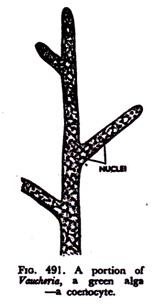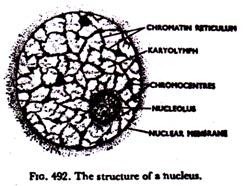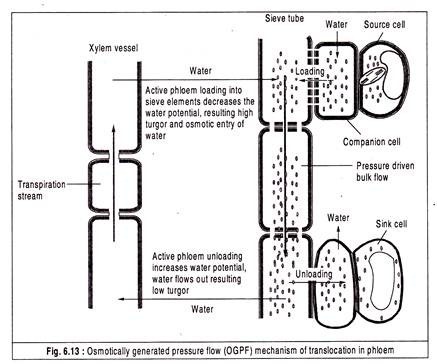In this article we will discuss about Phloem Transport. After reading this article you will learn about: 1. Mechanism of Phloem Transport 2. Factors Affecting Phloem Transport.
Mechanism of Phloem Transport:
The mechanism of long-distance transport through the sieve tube is soundly based on the internal organization of sieve tubes, without which it remains speculative. Phloem tissue is composed of the sieve elements, companion cells or albuminous cells, phloem parenchyma and phloem fibres. Of them, the sieve elements and companion cells are important for transport.
The sieve elements are anucleated, elongated living cells, through which transport actually takes place. They are connected end to end with porous sieve plates in between, forming long cellular channels called sieve tubes. The companion cells have dense cytoplasm with small vacuoles. Mitochondria, dictoysomes and endoplasmic reticulum are abundant. The nucleus is well-defined.
The sieve tube ultrastructure shows continuous smooth endoplasmic reticulum. Mitochondria in the sieve tubes are capable of carrying out cellular respiration. In mature sieve elements plastids are present with rudimentary internal membrane system. Microfilament bundles have been reported in mature sieve elements.
There are several kinds of fibrilar proteins having diameter of 7-24 nm and the molecular weights vary from 14,000 to 150,000.
These proteins are referred to as P-proteins (phloem proteins). The pores of the sieve plates are blocked with these P-proteins. The occlusion of pores does not favour the pressure flow hypothesis. Many theories, however, suggest that P-proteins play some kind of active role in pumping solution through the pores.
Whether the sieve plate pores are open or occluded by P-protein is still a question. Electron microscopic studies are post-vital observations. Observation of living functioning sieve tubes is exceedingly difficult because of their fragility. With these uncertainties of the internal structure actual explanation of the transport mechanism is still lacking.
However, the experimenters have presented various theories to explain the transport of photosynthates in the phloem which are as follows:
(i) Electro-Osmosis:
This mechanism suggests that an electric potential is maintained across the sieve plate. The electric potential exerts a force on the solution around the filamentous material fixed in the pores, thus causing flow through the plats.
Electric potentiality is maintained in the form of a continuous circulation of ions through the sieve pores and back through companion cells or even through walls of the sieve tubes (Spanner, 1958) (Fig. 6. 11). So, according to this mechanism the sieve plates are the origins of the force for movement and not an obstruction.
It is believed that K+ ions are moved through the pores and again circulated back to the same side of the plate by an ATP-driven potassium ion pump present in the membrane. Potassium ions have been found in adequate concentration in sieve tubes.
The fixed negative charges on the proteinaceous plug were assumed to be balanced by mobile potassium ions, which would be pulled by an electric potential difference across the sieve plate, in turn pulling along water and other solutes.
The main objection to this theory is that it does not show transport of ions of both positive and negative charges and polarized potentials across the sieve plates have not been found. Further, the efficiency of water movement (the number of water molecules moved per ion) have been found to be higher than that observed during electro-osmosis in non-living system.
(ii) Protoplasmic Streaming:
De Vries in 1885 suggested that protoplasmic streaming was responsible for the transport of sugar through the phloem. According to him protoplasm was circulated around the periphery of the sieve elements. Thus, like a conveyer belt or two-way escalator it facilitated bidirectional movement of trans-locates through the same sieve tube.
More recently in the 1960s, Thaine observed intercellular strands of protoplasm moving through the sieve pores from one sieve element to the next of the entire length of a sieve tube. He suggested that peristaltic pump and counter-current were responsible for the movement of trans-locates.
This cytoplasmic pumping in trans-cellular strands can account for the bidirectional translocation through different strands within a single sieve tube. But the mechanism is incapable of explaining the speeds and SMTs in the higher ranges, and the membrane bound strands have not been found.
Dempsey et al. (1975), however, found strands of appropriate size but not surrounded by membranes. In addition the maximum streaming rates observed in plant cells are less than 1 mm min-1 for slower than the rates typical of phloem transport (often 1 cm min-1 or max).
(iii) Contractile Protein Variants:
Fensom and Peel reported the presence of fibrilar proteins called P-proteins which oscillated in a manner resembling moving flagella. They also found particles attached to the micro fibrils moving in a bouncing motion resembling Brownian movement, but several times more rapid.
They claimed that these P-proteins played some kind of active role in pumping solution through the pores. Various such proposals have been made suggesting the generation of movement by the contractility (actin like activity) of P-protein filaments.
No positive actin reactions, such as binding with heavy meromyosin, have been detected. Sabins and Hart showed that the P- proteins are highly variable in their composition and are not contractile in nature.
(iv) Pressure-Driven Flow:
Pressure-flow or mass-flow hypothesis is the most widely accepted hypothesis at present, though there are a number of reservations. The hypothesis was proposed in its elemental form by a German scientist, E. Munch, in 1926.
The hypothesis rests on the assumption that a turgor-pressure gradient exists between the source and the sink. Trans-locates are carried passively in response to the pressure gradient caused by osmotic diffusion of water into the sieve elements at the source end and out of the sieve elements at the sink end. This type of translocation is called osmotically generated pressure flow (OGPF).
The hypothesis is simple and based upon a model that can be made in laboratory (Fig. 6.12).
Two osmometers A and B, permeable only to water, are connected to each other with a tube. Osmometer A contains solution that is more concentrated than its surrounding solution and osmometer B contains a solution less concentrated than that in A, but still higher than its surrounding medium. Both the surrounding solutions have open channels.
Since osmometer A contains more solutes, it will develop a higher turgor pressure which is transmitted throughout the system through the open channel, causing a passive mass-flow of water and solutes from A to B. Water comes out of B influenced by the pressure and is re-circulated through the open channel. If solutes can be added into A and removed from B continuously, the flow will continue.
According to Munch, the living plant contains a comparable system (Fig. 6.13). The sieve elements near mesophyll cells are analogous to A.
The sieve elements in this region are continuously loaded with sugars by the mesophyll cells and the concentration is kept high. In the sink end the sugar concentration in the sieve elements is always kept low as sugars become osmotically inactive through metabolism or are utilized in growth, stored as starch, or converted to fats.
The connecting channel between source and sink is the phloem and the surrounding dilute solutions are those of the apoplast and that in the xylem. So, according to Munch’s hypothesis the flow through the sieve tubes is passive, although there is evidence of involvement of metabolism in bulk flow.
The relevant points of pressure-flow mechanism are as follows:
1. Munch postulated that solute movement occurred in the phloem along a turgor pressure gradient from source to sink. For many years pressures in the phloem could not be measured directly. Gradients in osmotic potential in sieve tubes from source to sink have often been measured, with the most negative values being detected at the source.
Direct pressure measurement by attaching a pressure gauge to a shoot or by applying a pressure-cuff similar to those used in measuring blood pressure, shows the value as high as 2.4 MPa. H.T. Hammel (1968) measured pressure at two points on the Quercus rubrum trunk by a special micro needle. He obtained values that the Munch’s model predicts.
2. Active loading and unloading of sucrose favours pressure-flow hypothesis. Phloem loading is a highly appropriate modification of Munch’s model. Munch was quite unaware of active loading of phloem which produces a very negative osmotic potential in the companion cells, leading to an osmotic entrance of water and bulk flow.
3. The sieve tubes themselves do not seem to be involved in the active loading and unloading processes. Adjacent companion cells expend the necessary energy. According to Munch’s hypothesis, flow of sap through the sieve tubes is a passive phenomenon and does not require energy along the pathway to maintain the flow.
Inhibitory effects of low temperature or anoxia in some cases are transient effects, and phloem transport continues after certain adjustment period. This suggests that maintenance of the phloem transport system for bulk flow apparently requires only a minimum of metabolic energy. It is required for the loading and unloading processes.
4. Sieve plate pores are open channels as they favour the mechanism. Knoblauch and Van Bel, using a confocal laser scanning microscope, have been able to visualize the transport of sugars along with a green phloem – mobile fluorescent dye in the living sieve elements.
The sieve plates showed staining within the pores that were lined with plasma membrane and that the pores were open and not occluded. It should be kept in mind that pores in sieve areas and sieve plates are modified plasmodesmata.
5. Simultaneous bidirectional transport in a single sieve tube has not been detected. Transport in both directions has been detected in sieve elements of different vascular bundles in stems. The unidirectional transport through a single sieve element supports the Munch’s model.
(v) Objections to Pressure-Flow Hypothesis:
The hypothesis suggests that substances should move in the same direction and at the same velocity. It has been found that 14C sugars moved most rapidly, 32P-phosphates moved more slowly, and 3H,0 moved slowest of all. It is explained that water is exchanged rapidly along the pathway.
It goes out through the sieve-tube membrane into the surrounding tissues and again diffuses back into the sieve tube. While sucrose and phosphate do not move as readily through the membrane, they might move much faster than the water molecules.
There are a number of situations in which sieve tubes appear to carry two substances in opposite directions simultaneously. Trip and Gorham clearly demonstrated the presence of 14C assimilates and 3H glucose that moved from opposite directions in a single sieve tube. In minor veins of leaves, movement appears to go either way or both ways.
Many workers, however, suggest that bidirectional movement occurs in separate phloem ducts, a possibility under the pressure-flow system.
Again, the sieve plates themselves offer a considerable resistance to passive bulk-flow as postulated in the Munch’s model.
The phloem ultra-structure suggests that the pores are partially or completely blocked with P-proteins. So, though these objections remain a rudimentary barrier to the universal acceptance of the pressure-flow hypothesis, it may well turn out that pressure-flow is the most probable mechanism of phloem translocation.
Factors Affecting Phloem Transport:
Phloem transport is affected by several important factors which are as follows:
(i) Temperature:
Temperature plays an important role in translocation. There is an optimum range of temperature for maximum translocation rate. Hewitt and Curtis observed that the optimum range of temperature for translocation in bean plants was 20°C – 30°C.
Translocation has also been found to be irreversibly inactivated by temperatures above 50°C. Similarly, too low temperatures affect translocation rate. Low temperatures inhibit active phloem transport by preventing the involvement of metabolic energy.
There are two types of plants according to low-temperature sensitivity. For some plants such as cucumber and tomato the inhibition temperature is around 10°C and the inhibition persists for a longer period. They are chilling-sensitive plants. Another group of plants such as sugar beet, potato, etc., are chilling-insensitive. In these plants low temperature has a transient effect.
They can recover translocation speed and SMT after 60 to 90 min. even when the local cooling of an organ is maintained at 0°C.
Low temperature increases viscosity of the phloem sap which reduces the speed and alters membrane structures which disorganizes the contents and causes plugging of the sieve pores. In chilling-insensitive plants probably the membrane remains unaltered.
(ii) Inhibitors:
Certain metabolic inhibitors such as cyanide and dinitrophenol have been shown to inhibit carbohydrate translocation, supporting the use of respiratory energy in helping movement. Cyanide applied locally to phloem prevents translocation through the treated zone. The inhibitors do not reach phloem in intact plants and so to apply it the vascular bundle is exposed surgically.
Whether the inhibitor has its effect on the transport phenomenon or on the loading and unloading phenomena is difficult to assess. In both the cases translocation is inhibited. However, translocation rate is regulated more by the metabolism of the source and sink cells than by the metabolism of the conducting cells themselves.
(iii) Potassium and Boron Deficiency:
Potassium is abundantly present in phloem sap. Potassium deficiency affects the growth of fruits and storage organs.
Potassium circulation around the sieve plate increases translocation of sugar in sieve tubes. Circulation of potassium establishes a potential difference across the sieve plates which actually favours sugar translocation. But there is no general acceptance of this explanation. It is now believed that K+ ions are involved in loading in the minor veins in leaves.
Boron is also essential for sugar transport. There is no sufficient explanation for the function of boron in sugar transport. However, Gauch and Dugger, suggested that boron complexes with sucrose to form sugar-borate complex which might pass through the negatively charged membranes more readily than neutral sugar molecules.
(iv) Hormones:
In the actively growing regions growth-promoting phytohormones are present in high amounts. The actively growing regions act as stronger sinks and thus attract most of the nutrients from the source regions. Growth hormones stimulate growth in these regions.
So, it is suggested that growth hormones have a strong influence on phloem translocation. But this effect is indirect. It is very difficult to distinguish hormonal effects on translocation from hormonal effects on the metabolism of sink tissue for the attraction of trans-locates.
It can be said that phloem translocation is at least partially under the control of phytohormones such as the cytokinins, indole-3-acetic acid (IAA), and gibberellic acid (GA).
Of course, in intact plants there is no evidence that the endogenous levels of hormones in the various tissues bear any relation to phloem translocation. They affect assimilate partitioning by controlling sink growth, leaf senescence, and other developmental processes.


